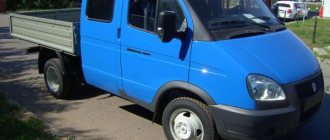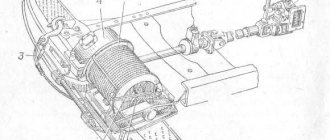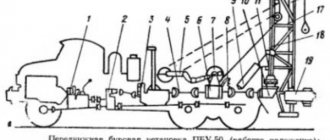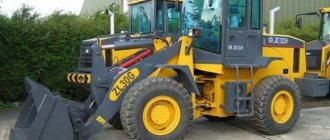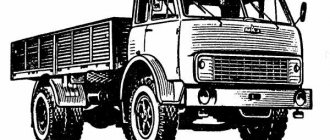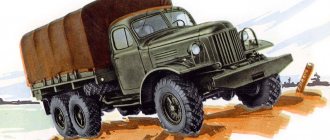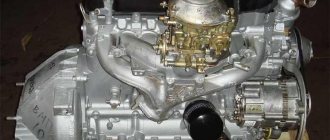GAZ-63 is a two-axle truck, mass production of which began back in 1948. The model was a variation of the popular national and utility truck GAZ-51. In addition, the GAZ-63 became a full-fledged replacement for the three-axle GAZ-AAA car of pre-war times.
This model was the first in the USSR to have all-wheel drive. Its mass production took place on a fairly large scale.
First of all, the truck was aimed at army needs. Here the technology became one of the best because it was resistant to harsh operating conditions. In addition, the GAZ-63 was used as a standard platform for the BTR-40.
North Korea and China were also involved in the production of this truck. In Korea, the model was called Sungri-61, and in China, as Yuejin NJ230 or NJ230A
Although the GAZ-63 proved to be excellent in the army, it was not entirely suitable for civilian purposes. The engine power was often not enough to complete the assigned tasks. Carrying capacity also introduced its limitations. For example, if a truck was loaded as much as possible, then it lost its high cross-country ability, and this was considered its main advantage.
Story
Designers began designing a new car in 1938. The actively used semi-trucks were already very outdated, both technically and morally. This prompted the Gorky plant to create new machines.
As a result, at the very beginning of the spring of 1938, the design staff of the Gorky Automobile Plant began the development of a new family of trucks with increased cross-country ability and intended for operation in difficult road conditions.
Several debut experimental copies of the GAZ-63 were created between 1939 and 1940 before the Great Patriotic War began. But due to the events that unfolded at that time, production of the models was postponed until 1948. The GAZ-63 was the most popular all-wheel drive truck in service with the Soviet Army, as well as a simple worker in the national economies of the entire Soviet Union from the 1950s to the 1960s.
The first experimental model was built in 1939. He was immediately sent to undergo various tests.
It is worth noting that the main emphasis when developing the new truck was on its all-terrain qualities. Therefore, its appearance is not much different from the trucks produced at that time.
The designers decided to install on the experimental GAZ-63 a cabin from a lorry that was popular at that time. But in all other respects, this truck turned out to be truly original. First of all, this concerns its chassis, which was designed especially for this model almost from scratch. As a result, the GAZ-63 received a 4x4 wheel arrangement and single-pitch tires for the rear wheels.
But the development didn't end there. Simultaneously with work on the off-road GAZ-63, the Gorky Automobile Plant began to design a similar version, but intended to fulfill civilian needs. This model was assigned the factory index GAZ-11-55. The model had high unification with the military 63rd Lawn.
The unification of the two models made it possible to reduce the cost of truck production, simplify operation, and also carry out mass production of these trucks on a common conveyor, which again reduces production costs. It is worth noting that the GAZ-51 and GAZ-63 were equipped with completely new design developments and technical solutions, which were also revolutionary in the mechanical engineering of that time.
All tests in which the GAZ-63 participated were carried out quite successfully. However, the mass production of trucks, planned for the early 1940s, was postponed by the management of the Gorky Automobile Plant. This was due to the beginning of the Great Patriotic War. They returned to the project again in 1943, but then the work was not on production, but on further development.
At that time, the design staff of the Gorky Automobile Plant managed to get acquainted with all-wheel drive trucks produced by American manufacturers. These were models such as Studabeker and Chevrolet. Their appearance is due to the fact that during the war, trucks were produced under Lend-Lease at the facilities of the Gorky Automobile Plant.
Seeing this situation, Gorky engineers did not miss their chance to study foreign technology and borrow some design developments from American manufacturers. But this does not mean that domestic models have repeated their foreign counterparts. The main components were completely designed or improved on the basis of existing components by Gorky engineers.
A new experimental batch of all-wheel drive vehicles, which received a number of improvements, was introduced in 1945. At the same time, various tests were again carried out on the trucks, where the results only got better. In 1948, the Gorky Automobile Plant began serial production of the GAZ-63 off-road trucks.
Distinctive feature
The GAZ-63 in its first models had fairly wide tires (from 9.75 to 18 inches), as well as single wheels on the rear axle, which had exactly the same track as their front “brothers”. This was done so that when the car was driving on snow, mud, sand, absolutely all the wheels would follow each other on the same track, without experiencing strong resistance to their rolling on the underlying surface due to the difference in track width. Somewhat later, during tests of all-wheel drive vehicles, the GAZ-63 was able to show “record performance in its cross-country ability” (quote based on a report by military experts) and was even used as a tractor for towing ZiS-151 stuck in the mud. These capabilities of the machine were appreciated.
Purpose
The GAZ-63 truck, thanks to its excellent technical and operational characteristics, as well as fairly high cross-country ability, gained great popularity in the Soviet Army. Here the car was mainly used to transport army personnel and any cargo. In addition, the truck towed military guns, and various combat installations could be installed on its platform, which made a special vehicle out of an ordinary truck.
This model was no less popular in the national economy, but here this was largely due to the conditions of the post-war period. At the end of the war, there were very few trucks for public needs, which is why they used what they had, and in this case it was the GAZ-63. The machine was used very actively and working with overload was not uncommon for it.
If the design did not raise even the slightest doubt about its reliability, the truck’s carrying capacity introduced its own limitations. Although the truck could carry fairly heavy loads, it sacrificed its high cross-country ability, which is why the GAZ-63 was developed.
In addition to the deterioration of all-terrain properties, a lot of parts were subject to severe wear during such operation. And carrying out timely maintenance of the truck in rural conditions was very difficult.
Modifications
In addition to the basic model, the Gorky Automobile Plant also produced various modified versions, including:
- Modification of GAZ-63A. Has an elongated frame design. The front version was equipped with a winch with a calculated traction force of 4500 kilograms. The winch operated using a power take-off driven by a driveshaft connected to the truck's transmission. The winch also had a cable 65 meters long;
- Modification of GAZ-63E. Has shielded electrical equipment. Otherwise, it is similar to the basic version of the truck;
- Modification of GAZ-63AE. Has shielded electrical equipment and a winch in the front of the frame. Otherwise, it is similar to the basic version of the truck;
- Modification of GAZ-63U. It is an export version of a standard truck;
- Modification of GAZ-63AU. It is an export version of the GAZ-63A modification;
- Modification of GAZ-63EU. Has shielded electrical equipment and is also an export option;
- Modification of GAZ-63Yu. This modification is intended for use in tropical conditions;
- Modification of GAZ-63EYU. The version has shielded electrical equipment and is also designed for use in tropical conditions;
- Modification of GAZ-63P. It is an all-wheel drive truck tractor. Unlike the base truck, it has smaller wheels. In addition, it can have both single-pitch and double-pitch tires on the rear axle. The modification was produced in limited quantities from 1958 to 1968:
- Modification of GAZ-33. It is an all-wheel drive three-axle truck with a 6x6 wheel arrangement. The maximum load capacity of this version is 3000 kilograms. The GAZ-63 platform was taken as the basis for the GAZ-33. The release of the first experimental models of the 33rd GAZ took place back in 1946. But mass production of such a modification was never realized. The main reason for this was the insufficient power of the power plant, which was borrowed from the GAZ-51.
Simultaneously with the basic modifications, various specialized vehicles were also produced based on the GAZ-63, namely:
- Modification of GAZ-63 ATSU-20. It is a fire truck tank;
- Modification of GAZ-63 PMG-19. It is a fire truck tank;
- Modification of GAZ-63 AR-1.6. Is a hose fire truck;
- Modification of GAZ-63 ASOP-5. Is a fire communication and lighting vehicle;
- Modification AS-3. It is a vehicle for sanitary purposes. Can carry seven stretchers and two seated wounded or sick;
- Modification of BTR-40. This modification is also known as the GAZ-40 and is an armored personnel carrier designed for eight soldiers and two crew members. The GAZ-63 platform was taken as the basis for this model. The power unit used was subjected to modifications, as a result of which its maximum power was increased to 80 horsepower. The development of the model began in 1947, and mass production from 1950 to 1960.
Appearance
The cabin of the brand new 1943 Lawn was almost identical to the American US-6 trucks. There was also a shortened hood, rectangular L-shaped wings, and a protective grille in front of the headlights. Many could even often confuse these two machines.
After a while, they presented the final variation, which was made in the likeness of the cabin of the 51st model, which had rounded wings and massive round headlights built into them. But, despite the changed appearance, the improved Soviet cabin was still similar to the prototype from America.
Initially, the Lawn 63 cabin was made of wood, because there was a significant shortage of sheet metal in the USSR. Only in 1950 the cabin was combined - wood and metal, where only the doors were made of wood. Only 6 years later they began to make an all-metal cabin, because only then did the national economy recover a little from the destruction brought by the war.
Body
The 63rd model military vehicle was equipped with a wooden universal body, which had high lattice side sides and a front wall. Inside there are folding benches of a longitudinal type. The tailgate was made with the possibility of opening. There were special sockets in the side boards in which arcs could be installed for subsequent tensioning of the awning.
It is clear that few people experienced pleasure from traveling in this “hard” car, however, as they say, driving is much better than walking, especially for a soldier. According to the passport, the car could carry about 1,500 kilograms on a dirt road. The GAZ-63A and GAZ-63P modifications already had 2,500 kilograms. The GAZ-63 also towed trailers whose weight did not exceed 2,000 kg, which significantly increased its functionality.
Based on the requirements of the military leadership, the design staff increased the capacity of the fuel tanks. As a result, the main ninety-liter tank had an additional 105-liter tank, which made it possible to increase the fuel volume to 780 kilometers with a full load.
Specifications
Engine
For the entire period of mass production, GAZ-63 was equipped with only one engine. It was a six-cylinder carburetor power plant with a lower valve arrangement, also installed on such a model as the GAZ-51. With a working volume of 3.5 liters, its maximum output power was 70 horsepower, which was quite enough for that time.
The engine had a liquid cooling system and could accelerate the truck to a maximum speed of 65 kilometers per hour.
Characteristics:
- Working volume – 3.48 l;
- Maximum power – 70 hp. (at 2800 rpm);
- Cylinder diameter – 82 mm;
- Piston stroke – 110 mm;
- The compression ratio in the combustion chamber is 6.2:1;
- The highest torque is 20.5 kgf/m (at 1500-1700 rpm).
Mass production
In the early autumn of 1948, serial production of the GAZ-63 began. By that time, he had successfully confirmed his characteristics by state tests, during which he climbed up to 30°, fords up to 0.9 m and ditches up to 0.76 m deep. The consumption of the cheapest gasoline A-66 ranged from 25 to 29 liters per 100 km, the load capacity on the highway was 2.0 tons, on a dirt road - 1.5 tons.
A significant drawback of this car was instability on high-speed turns. The ground clearance was 270 mm with a narrow track; it increased the truck's maneuverability, but at the same time, an increase in height led to capsizing on turns and slopes. This was especially true for tall special equipment on the GAZ-63 chassis, for example, vans or tanks.
In the summer of 1968, the last such production car was produced. Over the entire period, 474 thousand cars of various modifications were produced. They were exported to socialist countries, Finland, the Middle East, Asia and Africa.
Brake system
The service brake system is represented by shoe mechanisms with a hydraulic drive. Drum brake mechanisms were also used as a parking brake, but had a mechanical drive in the form of a cable.
It is worth noting that drum mechanisms in the parking brake began to be installed on trucks only in 1955. Previously, the model was equipped with disc brakes.
Advantages and disadvantages
Pros of the car
- Good maneuverability;
- Robust machine design;
- Good ride height;
- Many details are unified with other models;
- Relatively low price of the car;
- Small dimensions;
- Ability to transport small trailers;
- All-wheel drive system;
- Good maneuverability;
- There are different modifications;
- Some modifications received a fairly powerful winch.
Cons of the car
- Outdated cabin;
- Not very comfortable seats, lacking various adjustments;
- Fixed steering column;
- Poor visibility due to the long hood;
- The first models did not even have a heater;
- Weak power of the power unit;
- There is little free space in the cabin;
- Lack of hydraulic power steering and braking systems;
- Low load capacity;
- Frequent rollovers of the car when entering a turn at high speed;
- Production year.
Chassis
At the front, a dependent suspension is used, consisting of longitudinal semi-elliptical springs and double-acting hydraulic telescopic shock absorbers.
The rear suspension is also dependent and has the same longitudinal semi-elliptic springs, but there are no shock absorbers here.
dimensions
- Total length – 5525 mm;
- Full width – 2200 mm;
- Cabin height – 2245 mm;
- Wheelbase length – 3300 mm;
- Front track width – 1590 mm;
- Rear track width -1600 mm;
- Ground clearance – 270 mm;
- The smallest turning radius is 9700 mm.
Peculiarities
The main advantage of the GAZ-63 truck is its truly very high cross-country ability. This is also noted by all those who have ever worked on it.
With a not particularly powerful power unit, this truck coped with quite complex tasks. He could drive almost anywhere and this, again, with low engine power. The design was very reliable and simple. It was on the basis of the GAZ-63 that the legendary domestic all-terrain vehicle GAZ-66 was developed, which almost completely inherited the chassis from its predecessor.
Among other features, the car is unpretentious, simple maintenance and repair, and, of course, phenomenal reliability. Although the GAZ-63 had an all-wheel drive layout, if necessary, the driver could disable the front-wheel drive, which had a positive effect on fuel consumption.
Flaws
The engine used was not perfect. According to drivers, it had a rather short service life, and with intensive use it often did not last its entire service life.
The truck itself was quite slow and clumsy. Despite the presence of all-wheel drive, the transmission was not equipped with differential locks. In the event of any breakdown, it was quite difficult to find spare parts, not to mention nowadays, where if you can find them, the cost for them is usually very high.
Another disadvantage is the poor stability of the machine. This is due to the high center of gravity. Because of this, the car could easily fall on its side while negotiating difficult road sections. Also, such situations often happened due to the inexperience of drivers.
The risk of rollover has only increased if a military KUNG is installed on the truck chassis. It is worth noting that such equipment had a mass of about 1500 kilograms and a very high height. All this had a negative impact on stability, which is why the car required the driver to drive slowly and very carefully when moving through terrain with difficult terrain.
It is worth noting that very sealed, warm and fully shielded KUNGs were offered for the GAZ-63. All this made it possible to significantly reduce interference when using radio stations and wired communication equipment. In addition, the car was equipped with shielded wiring, an ignition coil, a distributor, spark plug caps and high-voltage wires. The model was also equipped with special radio interference filters.
Design features of the GAZ-63
The truck is distinguished by a frame design, an all-wheel drive system with a switchable front axle (a pair of cardan shafts to the drive axles plus an intermediate one between the gearbox and transfer case), short overhangs (small overhang - large departure or approach angle) and single wheels with powerful tires. tread. By the way, in those years all trucks were still framed: trucks with semi-supporting or load-bearing bodies (like on a passenger car chassis) did not yet exist.
The tires of the GAZ off-road truck had a size of 10.00–18″. The pressure in them could be changed when overcoming various types of off-road conditions, within the range from 4 to 0.5 kgf/cm2. There were no compressors at that time, so to inflate tires in field conditions, a device was used that was located under the body, was switchable, and driven by a gearbox.
Later, a tire inflation device from the engine appeared, screwed into place of one of the spark plugs. At the same time, the engine operated on five cylinders, and the piston of the sixth cylinder pumped compressed air into the truck tires. However, one should not think that the tires were inflated in this way not with air, but with a gasoline-air mixture. Since the inlet air valve of the device had significantly less resistance than the intake manifold and carburetor with an inertia-oil air cleaner. Although a small portion of gasoline vapors certainly got into the inflated tire.
On off-road roads in those days, the GAZ-63 had practically no worthy competitors (not counting the ZIL-151).
An interesting feature of the GAZ-63 design is its extremely simple and effective engine preheating system. A special preheating boiler was mounted under the hood, on the right side of the engine. In frosty weather, you had to turn the steering wheel all the way to the left, open the hatch in the fender of the right front wheel, and insert a lit blowtorch into the fire tube of the boiler.
In this way, the liquid in the cooling system was heated, as well as the engine oil in the oil pan. When heating a “dry” engine, five liters of water were poured into the boiler, after which it was heated with the resulting steam. Then start the engine and add water to the radiator.
What is typical is that the GAZ-63 of the first years of production was equipped with engine pre-heaters, but they did not have a heater in the cabin at all! In winter, it was necessary to work in such a machine not only in a padded jacket, but preferably even in a warm sheepskin sheepskin coat, high boots and thick mittens.
But, starting in 1952, the design of the car already included a standard factory heater for the cabin. By means of an electric fan, warm air was supplied to the windshield, and it was supplied to the feet of the seated driver and passenger when the car was moving, through an air intake that opened behind the hood.
Access to the engine for maintenance and repair, as well as for cooling, was greatly simplified thanks to the removable side panels of the hood trim.
Price
The GAZ-63 truck was discontinued from mass production a long time ago. But even now you can find completely working copies.
Thus, a car in working condition can now be purchased at a minimum price of 80 thousand rubles. However, when buying this option, you should remember that for such a price, equipment in most cases requires painstaking restoration.
Another option, and a very popular one, is to purchase a truck that was taken out of military storage in the 1980s and 1990s. Most often, such machines are equipped with KUNGs and are in excellent technical condition. The cost of this option on average reaches 450 thousand rubles, depending on the equipment.
Modernization
They tried to eliminate the identified deficiency already in 1954. For this purpose, two modernized models of the car were created: GAZ-63V and GAZ-63 AB. However, in the end, the customer completely rejected these options, since, in his opinion, the existing shortcomings were not leveled out. Of course, engineers continued to try to find a solution to the problem, but practice showed that it was much easier to create a completely new car than to improve an old one.
Subsequently, on the basis of the “sixty-third”, such special-purpose vehicles were created as: an armored personnel carrier, a tanker, an ambulance, a rocket artillery vehicle and others.
In 1952, the production of AS-3 ambulances with a van body, which was designed for seven lying patients and two sitting ones, was mastered. Next, the ASh-3 headquarters vehicle was created.
In 1959, by order of the defense department, several copies of PAZ-654 staff buses were created based on the GAZ-63 chassis. Moreover, their internal “stuffing” consisted of tables, seats, radio equipment, fire extinguishing equipment, and devices for holding small arms.
In 1962, a car carrying containers for transporting nuclear waste was developed. It was based on the GAZ-63, only with a smaller chassis. At the same time, the base of the machine was also lengthened and an auxiliary driveshaft and additional support were installed. The machine was equipped with a special crane-reloader PSh-04. Thanks to this, the replacement body was located at a distance of almost 4 meters from the driver’s cab. This ultimately made it possible to do without the use of a special lead screen, which would have weighed a thousand kilograms.
Links
GAZ buses GAZ-03-30 • GAZ-05-193 • GAZ-55 • GZA-651 • “GAZelle” • “GAZelle-Business” • “Sobol” • “GAZelle-Next” GAZ special equipment GAZ-VM • GAZ-46 • Half-track vehicle based on GAZ-63 • GAZ-47 (GT-S) • GAZ-71 (GT-SM) • GAZ-34039 • GAZ-34039 “Irbis” • GAZ-34039K “Irbis” » • GAZ-3409 “Beaver” • GAZ-3344 • GAZ-3351 • “Tiger” • GAZ-3937 • GAZ-5903 (BTR-80) • GAZ-59039 (BMM-80) • GAZ-5903V “Vetluga” • GAZ-5903Zh • GAZ-59402 “Blizzard” Post-war BKM and military vehicles of the USSR, Ukraine and Russia p • o • r
Trucks MAZ-502 • ZIS-151 • ZIL-131 • ZIL-157 • ZIL-135 • ZIL-4334 • GAZ-63 • GAZ- 66 • GAZ-33097 • Ural-375D • Ural-4320 • Ural-5323 • KrAZ- 214 • KrAZ-255B • KrAZ-260 • KrAZ-5233 • KAMAZ-4310 • KAMAZ 6350 • KAMAZ 63501 Armored personnel carriers BTR-40 • BTR-50 • BTR-60 • BTR-70 • BTR-80 • BTR-90 • BTR-152 • BTR-D Armored reconnaissance vehicles Artillery tractors and other vehicles BRDM-1 • BRDM-2 • BRM-1K • BRM-3K AT-S • ZIS-485 • ATS-59G • AT-P • MT-LB • PTS • AT-T • MT-T • AT-L • GAZ-69 • UAZ-469 • LuAZ-967 • “Progress”


